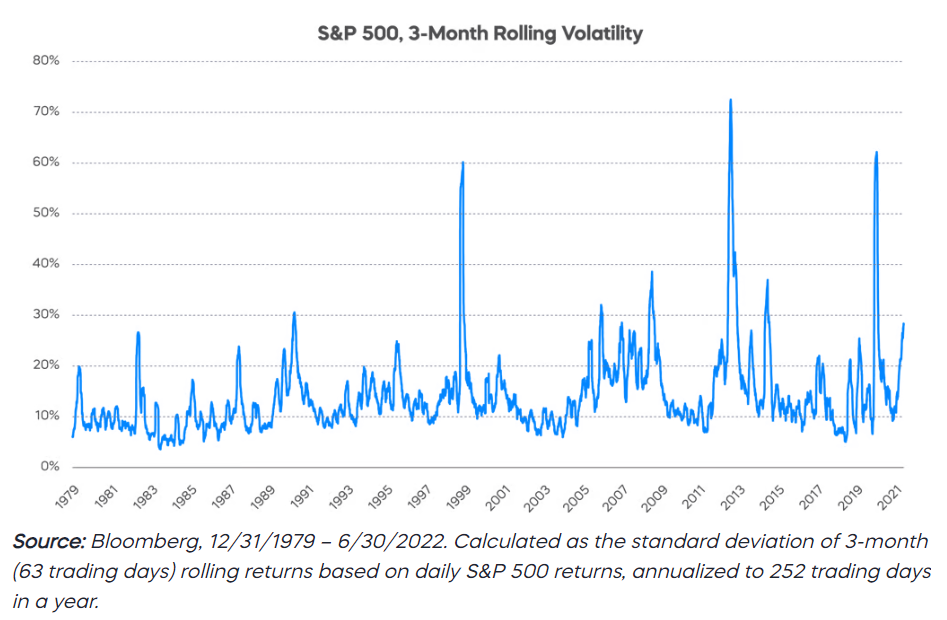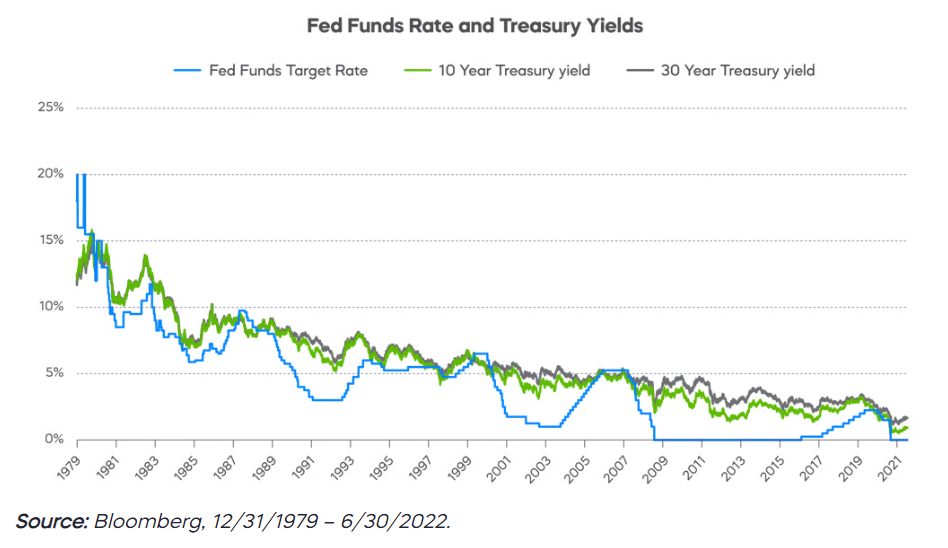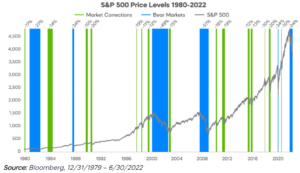Investing involves risk. Market downturns will happen. Having a sound investment strategy can help smooth out the turbulence in your portfolio and save you from getting caught up in a herd mentality of selling low into a down market. What’s the best approach?
There are a number of possible answers. Hedging is one popular strategy for mitigating the effects of market downturns. Before we talk more about hedging though, let’s examine recent market history to help illustrate the inherent market risks we face every day.
Downturns and Volatility in the U.S. Equity Market
Since 1980, there have been numerous market corrections (defined as a drop of 10% or more) and six bear markets (declines of 20% or more). In the 1980s, we had the Latin American debt crisis and the stock market crash of 1987. The 1990s were spared any defined bear markets, but they were followed by the technology bubble and the Financial Crisis in the 2000s. In late 2018, the equity market battled a deep correction that nearly entered bear market territory as it digested Fed rate hikes, trade tensions between the U.S. and China, and renewed volatility. In early 2020, we experienced a sharp bear market driven by the COVID-19 pandemic. Most recently, over the first half of 2022, equities fell sharply as the market faced persistent high inflation and resultant monetary policy tightening. In fact, the S&P 500 posted its worst return for the first half of the year since 1970.1

Volatility in financial markets reached historically significant levels in 2020 as COVID-19 impacted the economy, public health, and daily life in the U.S. and around the world. This volatility was of similar magnitude to what was experienced during the 2008 Financial Crisis and Market Crash of 1987.


Fixed Income—Rising Rates amid High Inflation and Tighter Monetary Policy in 2022
While bond yields had been on a downward trajectory over the past 40 years, they hit historically low levels in 2020 as a result of the pandemic’s impact on the economy and financial markets. The Federal Reserve lowered the Fed Funds target rate to 0.00–0.25%. In 2020, 10- and 30-year Treasury yields fell as low as 0.51% and 1.00%, respectively.2 This had many investors wondering how much lower yields could go. It also presented challenges for investors managing fixed income exposure and portfolios. Treasury yields subsequently rose off the historically low levels as the economy recovered with the help of supportive monetary and fiscal policies. In the first half of 2022, the Fed started pursuing tighter monetary policies amid high inflation, and Treasury yields moved meaningfully higher, which can lead to losses (potentially significant) in bond portfolios. Intermediate and long-term U.S. treasury indexes declined 11% and 22%, respectively, for the first half of the year.3 These losses came at a time where equities also suffered, leaving many investors relying on traditional diversification with stocks and bonds with meaningful losses in their portfolios.


Portfolio Hedging to Mitigate the Effects of Market Downturns
Investors can consider hedging strategies to mitigate market risk. A hedge, in its simplest form, is an investment intended to move in the opposite direction of an asset in your portfolio that you consider to be at risk. A hedge provides inverse exposure. If the at-risk investment should decline in value, the hedge is designed to increase in value and offset potential losses in your portfolio.
Hedging is a flexible strategy. You can apply it broadly in an effort to help minimize loss across entire asset classes in your portfolio—to help shield your equity, fixed income, commodity or even currency allocations. Or, you can hedge narrowly to help shield individual sectors or even specific stocks. There are a number of hedging strategies available, and the best one for you will depend on your specific needs, goals and tolerance for risk.
Used strategically, portfolio hedging can become part of your long-term investment strategy. Deployed tactically, a hedge can be applied and removed as needed, without disturbing your core strategy or long-term goals, to help provide short-term shelter from adverse market events. Hedging your portfolio can provide you with an alternative to selling in a down market, realizing investment losses, and potentially generating significant redemption fees, transaction costs and tax consequences. Of course, hedging strategies have unique risks, costs and consequences of their own (i.e., fund management fees, rebalancing costs, taxable events, etc.). It is important that you fully understand the strategy you plan to use and read the prospectuses for any investments you intend to use as a hedge.
1 Source: Bloomberg
2 Source: Bloomberg
3 Source: Bloomberg, intermediate and long-term U.S. treasury indexes measured using ICE US 7-10 and 20+ year US Treasury indexes.
—
Originally Posted May 2023 – Part I: The Significance of Portfolio Hedging
This information is not meant to be investment advice.
Shares of any ETF are generally bought and sold at market price (not NAV) and are not individually redeemed from the fund. Brokerage commissions will reduce returns.
Short ProShares ETFs seek returns that are a multiple of (e.g., -1x or -2x) the return of a benchmark (target) for a single day, as measured from one NAV calculation to the next. Due to the compounding of daily returns, Geared ProShares’ returns over periods other than one day will likely differ in amount and possibly direction from the target return for the same period. These effects may be more pronounced in funds with larger or inverse multiples and in funds with volatile benchmarks. Investors should monitor their holding as frequently as daily. For more on risks, please read the prospectus.
There is no guarantee any ProShares ETF will achieve its investment objective.
Investing involves risk, including the possible loss of principal. Short ProShares ETFs are non-diversified and entail certain risks, which may include risk associated with the use of derivatives (swap agreements, futures contracts and similar instruments), imperfect benchmark correlation, leverage and market price variance, all of which can increase volatility and decrease performance. Short ProShares ETFs should lose money when their benchmarks or indexes rise. Please see their summary and full prospectuses for a more complete description of risks.
Carefully consider the investment objectives, risks, charges and expenses of ProShares before investing. This and other information can be found in their summary and full prospectuses. Read them carefully before investing.
Disclosure: ProShares
Any forward-looking statements herein are based on expectations of ProShare Advisors LLC at the time. Whether or not actual results and developments will conform to ProShare Advisors LLC’s expectations and predictions, however, is subject to a number of risks and uncertainties, including general economic, market and business conditions; changes in laws or regulations or other actions made by governmental authorities or regulatory bodies; and other world economic and political developments. ProShare Advisors LLC undertakes no duty to update or revise any forward-looking statements, whether as a result of new information, future events or otherwise.
Investing involves risk, including the possible loss of principal. This information is not meant to be investment advice.
Disclosure: Interactive Brokers
Information posted on IBKR Campus that is provided by third-parties does NOT constitute a recommendation that you should contract for the services of that third party. Third-party participants who contribute to IBKR Campus are independent of Interactive Brokers and Interactive Brokers does not make any representations or warranties concerning the services offered, their past or future performance, or the accuracy of the information provided by the third party. Past performance is no guarantee of future results.
This material is from ProShares and is being posted with its permission. The views expressed in this material are solely those of the author and/or ProShares and Interactive Brokers is not endorsing or recommending any investment or trading discussed in the material. This material is not and should not be construed as an offer to buy or sell any security. It should not be construed as research or investment advice or a recommendation to buy, sell or hold any security or commodity. This material does not and is not intended to take into account the particular financial conditions, investment objectives or requirements of individual customers. Before acting on this material, you should consider whether it is suitable for your particular circumstances and, as necessary, seek professional advice.





















Join The Conversation
If you have a general question, it may already be covered in our FAQs. If you have an account-specific question or concern, please reach out to Client Services.